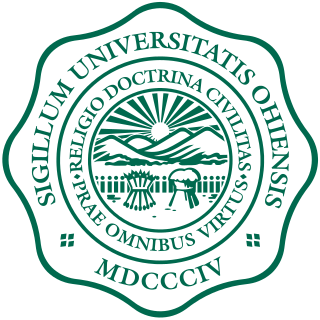
The Graduate School and University Center of the City University of New York is a public research institution and post-graduate university in New York City. It is the principal doctoral-granting institution of the City University of New York (CUNY) system. The school is situated in the landmark B. Altman and Company Building at 365 Fifth Avenue in Midtown Manhattan, opposite the Empire State Building. The Graduate Center has 4,600 students, 31 doctoral programs, 14 master's programs, and 30 research centers and institutes. A core faculty of approximately 140 is supplemented by over 1,800 additional faculty members drawn from throughout CUNY's eleven senior colleges and New York City's cultural and scientific institutions.

Ohio University is a public research university in Athens, Ohio. The first university chartered by an Act of Congress and the first to be chartered in Ohio, it was chartered in 1787 by the Congress of the Confederation and subsequently approved for the territory in 1802 and state in 1804, opening for students in 1809. Ohio University is the oldest university in Ohio, the tenth oldest public university in the United States and the 32nd oldest among public and private universities. As of fall 2020, the university's total enrollment at Athens was slightly more than 20,000, while the all-campus enrollment was just over 33,000.

Friedrich–Alexander University Erlangen–Nürnberg is a public research university in the cities of Erlangen and Nuremberg in Bavaria, Germany. The name Friedrich–Alexander comes from the university's first founder Friedrich, Margrave of Brandenburg-Bayreuth, and its benefactor Christian Frederick Charles Alexander, Margrave of Brandenburg-Ansbach.

Steve Ballard is a former chancellor at East Carolina University. On June 1, 2004, Chancellor Ballard began his new job, becoming the tenth chief administrator at ECU.

Mahmoud Mohieldin, born on 15 January 1965 in Egypt, is the World Bank Group's Senior Vice President for the 2030 Development Agenda, UN Relations, and Partnerships. He serves as a Board member on the Global Partnership for Sustainable Development Data, as well as an observer to the EU Multi-Stakeholder Platform for the SDGs. Dr. Mohieldin previously served as Corporate Secretary, President's Special Envoy, and Managing Director for the World Bank Group.
The School of Public and International Affairs (SPIA) at Virginia Tech offers graduate and undergraduate education in the fields of public administration, public policy, international affairs, urban affairs, and urban & regional planning. It has three campuses throughout Virginia: Arlington; Blacksburg and Richmond.

The McCourt School of Public Policy is one of ten constituent schools of Georgetown University. The McCourt School offers master's degrees in public policy, international development policy, policy management, data science for public policy, and policy leadership as well as administers several professional certificate programs and houses fifteen affiliated research centers. The McCourt School has twenty-one full-time faculty members, ten visiting faculty members, more than one-hundred adjunct faculty members and approximately 450 enrolled students across the various degree and executive education programs.
The Levada Center is a Russian independent, nongovernmental polling and sociological research organization recognized as a foreign agent under the 2012 Russian foreign agent law. It is named after its founder, the first Russian professor of sociology Yuri Levada (1930—2006). The Center traces back its history to 1987 when the All-Union Public Opinion Research Center (VTsIOM) was founded under the leadership of academician Tatyana Zaslavskaya. Being one of the largest Russian research companies, the Levada Center regularly conducts its own and commissioned polling and marketing research.

The Andrew Young School of Policy Studies at Georgia State University houses the Criminal Justice & Criminology, Economics, School of Social Work, Urban Studies and Public Management & Policy departments. Georgia State University is the largest university in the state of Georgia.
The Stanford School of Earth, Energy & Environmental Sciences, which changed its name from the School of Earth Sciences in February 2015, is one of three schools at Stanford awarding both graduate and undergraduate degrees. Stanford's first faculty member was a professor of geology; as such it is considered the oldest academic foundation of Stanford University. It is composed of four departments and two interdisciplinary programs. Research and teaching span a wide range of disciplines.
The State Farm Research and Development Center opened in January 2005 at the University of Illinois’ Research Park. State Farm has been involved in academic programming, student assistance and research at U of I for over 35 years, but this facility allows for a captive audience of college interns working on projects to benefit the company as a whole, while students get to apply what they learn in class to real business problems.

The Interdisciplinary Center for Scientific Computing is a scientific research institute of the Heidelberg University, Germany. It centralizes scientific activity and promotes research and work in scientific computing. Founded in 1987 by the Heidelberg University and the state of Baden-Württemberg, IWR participates in joint project and cooperations with industry in Germany as well as abroad. As a research institute with about 380 staff, IWR is considered one of the world's largest research centers for scientific computing.
The Norwegian Centre for Violence and Traumatic Stress Studies is a research centre in Oslo, Norway, and Norway's national research institution in violence and sexual abuse; disaster management, terrorism, armed conflicts and traumatic stress; and forced migration and refugee health research. It is interdisciplinary and employs experts mainly in psychology, psychiatry, and the social sciences. In addition to carrying out research and related activities, the institute advises the Government of Norway in its areas of expertise and has some official emergency management functions at the national level. NKVTS has 101 employees.
Stanford University has many centers and institutes dedicated to the study of various specific topics. These centers and institutes may be within a department, within a school but across departments, an independent laboratory, institute or center reporting directly to the Dean of Research and outside any school, or semi-independent of the University itself.

The Health Sciences Center for Global Health (HSCGH) at The Ohio State University (OSU) is a collaborative program among the OSU Colleges of Dentistry, Medicine, Nursing, Optometry, Pharmacy, Public Health, School of Health and Rehabilitation Sciences and Veterinary Medicine. The HSCGH is led jointly by the Colleges of Medicine (COM) and Public Health (CPH).

The University of Michigan Institute for Social Research (ISR) is one of the largest academic social research and survey organization in the world, established in 1949. ISR includes more than 250 scientists from many academic disciplines – including political science, psychology, sociology, economics, demography, history, anthropology, and statistics. It has been said to be "the premier center for survey research methodology in the world."
The Partnerships Advancing Library Media (PALM) Center is a research institute at Florida State University (FSU) in Tallahassee, Florida, United States. The center was established as a joint effort of the FSU Learning Systems Institute, College of Communication and Information and the College of Education. The Center engages in research and evaluation focused on school librarians ranging from large-scale surveys and evaluation of program implementation, to case studies of school libraries.
The Carl R. Woese Institute for Genomic Biology (IGB) is an interdisciplinary facility for genomics research at the University of Illinois at Urbana-Champaign. The construction of the IGB, which was completed in 2006, represented a strategy to centralize biotechnology research at the University of Illinois. A goal of the IGB is to provide a collaborative environment in which researchers with diverse backgrounds are drawn together by their pursuit of scientific questions related to genomics. The interdisciplinary nature of the institute promotes the creation of innovative solutions to societal challenges related to health, the environment, and food production. Current research at the IGB explores the genomic bases of a wide range of phenomena, including the progression of cancer, the ecological impact of global change, tissue and organ growth, and the diversity of animal behavior.
The Princeton Institute for International and Regional Studies (PIIRS) is the main research center for international studies and area studies at Princeton University and is one of the oldest centers of its kind in the United States. The Institute focuses on an interdisciplinary approach and its associated faculty is drawn from more than 150 professors and other scholars from more than 25 different departments within Princeton. Its director is historian Stephen Kotkin, the John P. Birkelund ’52 Professor in History and International Affairs.
Med Jones a.k.a. Med Yones is an American economist. He is the president of International Institute of Management, a U.S. based research organization. His work at the institute focuses on economic, investment, and business strategies.